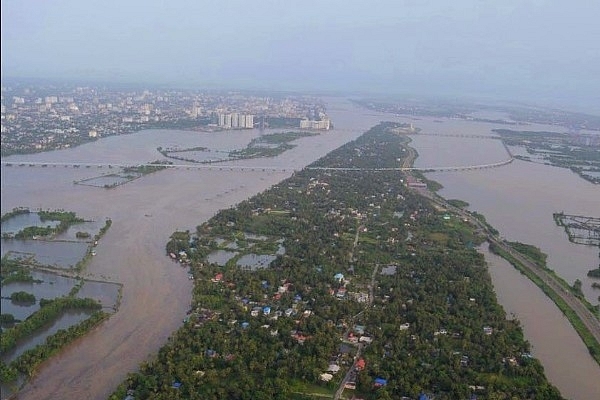
What Has Made Kerala Vulnerable To The Current Flood Situation?
Owing to torrential rains, parts of Kerala have been immobilised, with water levels rising alarmingly and catching people off guard.
Twenty-four dams in Kerala have been opened – something that has not happened in the last 25 years.
This year’s monsoon has been a little unkind to Kerala, with the state witnessing effects of it never been seen in recent memory. Kerala has been under torrential rain for almost a month now, with the daily rainfall count being 100 mm on most days. Initially, it was parts such as Alappuzha that were affected. Now, it is northern Kerala, causing untold misery to humans and animals alike. So far, the rains have claimed 178 lives, and the toll threatens to rise.
In addition, 24 dams in Kerala have been opened – again, something that has not happened in the last 25 years. The Idukki dam has been opened after 26 years. A native of the Kuttanad area in Alappuzha told Swarajya that water entered their home for the first time in 84 years. “Our family has been here since 1934. It is the first time that waters have entered our house.”
The Kuttanad area is at least fortunate because the water spreads out instead of rising. “Unlike other places, water level doesn’t rise alarmingly here. It spreads out. The effect is that it takes time for the water to drain out, which will force us to tread through water for a longer time,” the native, who did not wish to be identified, said.
On the other hand, places in northern Kerala have been immobilised with water levels rising alarmingly. The problem for Keralites has amplified mainly because the torrential rains have forced open many a dam, resulting in flooding, and catching them off guard.
According to the Kerala State Electricity Board, dams such as Sholayar, Idamalar, Kuttiadi, and Thariode are filled to capacity. This has forced government authorities to open the dams since inflows continue from the catchment areas. Two other major dams – Idukki and Pamba – are filled to 98 per cent of their capacity, again compelling authorities to open them as a precaution. The opening of the Pamba dam has resulted in water level rising up to the Ganapathy temple at Sabarimala, an unprecedented incident in over two decades.
“We are able to feel the effect of Pamba’s opening here as water level has increased. But there is nothing much to be scared,” said the Kuttanad native.
Kerala has been assured of all help by the centre, with Prime Minister Narendra Modi and Union Home Minister Rajnath Singh calling up Chief Minister Pinarayi Vijayan to say so. Army and paramilitary forces have been rushed to the state, and other emergency measures are being taken to minimise the damage there.
But floods and landslides have raised a question: what has gone wrong with Kerala’s landscape that things have turned this bad?
Malayalam daily Manorama quoted Kerala Dam Safety Authority Chairman Justice Ramachandran Nair as saying that houses built after reclaiming paddy fields and large complexes replacing farms have led to the flooding in Kuttanad area.
Citizens, too, are to be blamed for such effects as landslides, as they have built houses encroaching sensitive areas, Nair said.
Experts say the problem with Kerala is the poor planning for utilising land. The state has never faced any mega disaster, either in terms of flooding or earthquake, for over 100 years now, and it has made people complacent. Industrial units, houses, and even infrastructure projects in the state have come up in areas that are prone to natural hazards like flooding.
In 1924, Kerala witnessed unprecedented floods, but in those areas that were affected, airports, schools, and hospitals have sprung up. As a result, they are all facing danger from the current floods.
Idukki, the one area that is threatened most with the opening of the dam, is seen as a classic example of how haphazard land use can wreak havoc. Idukki is a quake-prone zone, yet it is a region that is witnessing many construction activities. Quarrying is also being carried out in the region, exposing it to further danger. Despite being warned of the impending dangers, the people there chose to do as they liked, throwing caution to the wind.
The view is that the Kerala government should also share the blame, as it has not sensitised the community enough to the imminent dangers of tinkering with the environment and ecology. There is also a section of people that says the Kerala government shouldn’t have waited for the water levels to rise to such alarming levels before letting out the water. Two more months remain before the south-west monsoons end. Authorities should have taken that into account and acted earlier. No one seems to have learnt from the 2015 Chennai floods.
Authorities agree that they have been able to reduce the impact to a great extent because they were prepared, but can they be lucky every time? Ockhi cyclone caught the authorities unaware. Only proactive steps, in addition to prior preparation, can minimise the effects.